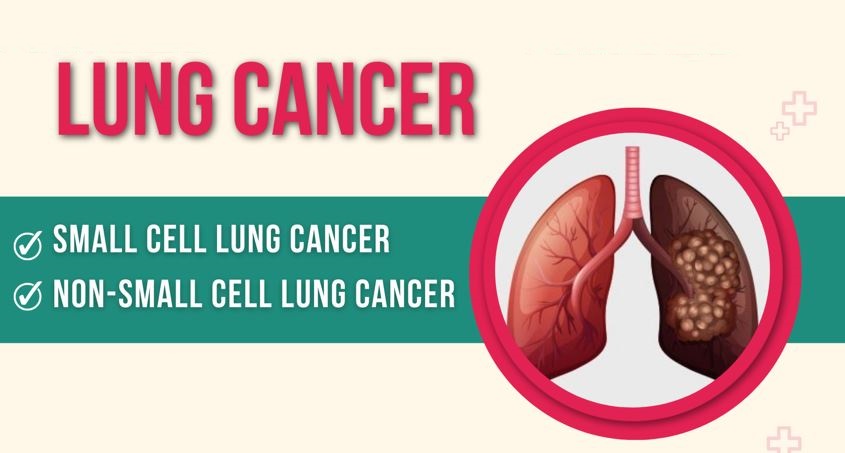Lung cancer is one of the most prevalent and deadliest forms of cancer worldwide. Despite advancements in medical research, it remains a significant health challenge due to its often late diagnosis. However, understanding the different types of lung cancer and recognizing the symptoms early can make a life-saving difference. This article will delve into the most common types of lung cancer, their characteristics, and key symptoms to watch for.
Understanding Lung Cancer
Lung cancer develops when cells in the lungs grow uncontrollably, forming tumors that can interfere with the lung’s normal functions. The disease is typically categorized into two main types: Non-Small Cell Lung Cancer (NSCLC) and Small Cell Lung Cancer (SCLC).
Both types differ in growth rates, treatment options, and prognosis, but they share common risk factors such as smoking, exposure to hazardous substances (e.g., asbestos), air pollution, and genetic predisposition.
Types of Lung Cancer
- Non-Small Cell Lung Cancer (NSCLC)
NSCLC accounts for approximately 85% of all lung cancer cases, making it the most common type. It is further divided into three subtypes:- Adenocarcinoma: This type is the most prevalent form of NSCLC, often found in non-smokers or former smokers. It originates in the outer areas of the lungs and tends to grow slower than other forms.
- Squamous Cell Carcinoma: Commonly linked to smoking, this cancer develops in the central part of the lungs, often near the bronchi.
- Large Cell Carcinoma: Known for its rapid growth, this subtype can appear in any part of the lung, making it more challenging to diagnose and treat early.
- Small Cell Lung Cancer (SCLC)
Representing about 15% of lung cancer cases, SCLC is more aggressive and fast-growing than NSCLC. It typically starts in the bronchi and quickly spreads to other parts of the body. Due to its rapid progression, early detection is crucial for improving survival rates.
Early Symptoms of Lung Cancer
Detecting lung cancer in its early stages can be difficult because symptoms often mimic less severe respiratory conditions. However, staying alert to the following signs can help:
- Persistent Cough: A cough that lingers for more than three weeks or worsens over time is a common early symptom.
- Shortness of Breath: Difficulty breathing during routine activities, such as climbing stairs or walking, can be an early indicator.
- Chest Pain: Discomfort or pain in the chest area, especially when coughing, laughing, or breathing deeply, should not be ignored.
- Coughing Up Blood: Even small amounts of blood in mucus are a red flag and require immediate medical attention.
- Unexplained Weight Loss: Sudden and significant weight loss without changes in diet or exercise could signal lung cancer.
- Fatigue: Persistent tiredness that doesn’t improve with rest is a common symptom of many cancers, including lung cancer.
- Hoarseness: Changes in the voice, such as hoarseness, may occur if the cancer affects the nerves controlling the vocal cords.
- Recurring Respiratory Infections: Frequent bouts of bronchitis or pneumonia can indicate an underlying problem, such as lung cancer.
Diagnosing Lung Cancer
Early diagnosis is key to successful treatment. If you experience any of the symptoms mentioned above, consult a healthcare professional promptly. Common diagnostic methods include:
- Imaging Tests: Chest X-rays, CT scans, and MRIs help visualize tumors or abnormalities in the lungs.
- Sputum Cytology: Examining mucus coughed up from the lungs can reveal cancer cells.
- Biopsy: A sample of tissue taken from the lungs through bronchoscopy or needle aspiration confirms the presence of cancer.
Treatment Options
Treatment for lung cancer depends on the type, stage, and overall health of the patient. Common approaches include:
- Surgery: Removing the tumor or affected portion of the lung is often the first step for localized NSCLC.
- Radiation Therapy: High-energy rays target and destroy cancer cells, often used alongside surgery or chemotherapy.
- Chemotherapy: Anti-cancer drugs are administered to kill or stop the growth of cancer cells, especially in advanced stages.
- Targeted Therapy: This newer treatment focuses on specific genetic mutations in cancer cells, offering a more personalized approach.
- Immunotherapy: Boosting the body’s immune system to fight cancer is an emerging and promising treatment option.
Preventing Lung Cancer
While some risk factors, like genetics, cannot be controlled, adopting a healthy lifestyle can significantly reduce the risk of developing lung cancer:
- Quit Smoking: Smoking is the leading cause of lung cancer. Quitting at any age lowers your risk.
- Avoid Secondhand Smoke: Limit exposure to environments with high levels of tobacco smoke.
- Minimize Exposure to Carcinogens: Wear protective gear when working with hazardous materials like asbestos or radon.
- Adopt a Healthy Diet: A diet rich in fruits, vegetables, and whole grains supports overall lung health.
- Exercise Regularly: Physical activity improves lung function and overall immunity.
When to Seek Medical Help
If you notice persistent symptoms, such as a chronic cough, unexplained weight loss, or shortness of breath, don’t wait to see a doctor. Early consultation can lead to timely diagnosis and treatment, improving survival chances significantly.
Conclusion
Lung cancer is a severe and potentially life-threatening condition, but early detection can save lives. Understanding the different types of lung cancer and staying vigilant about symptoms are vital steps in combating this disease. If you or a loved one experiences any concerning signs, seek medical advice without delay. With ongoing research and advancements in treatment, the outlook for lung cancer patients continues to improve.

